mobile View, to the German Version tap the flag


- Landscape within the Russian Federation
- own name: Sibir
• Flags and Coats of Arms
• Meaning/Origin of the Flags
• Numbers and Facts
• History
• Origin of the Country's Name
• Alexander Vasilyevich Kolchak

15th/16th century,
supposed flag of the Khanate of Sibir,
Source, by: Stateless Nations




1917,
Flag of the Siberian Republic,
ratio = 2:3,
Source, by: Wikipedia (RU),
Stateless Nations



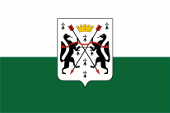
1917, Variante,
Flag of the Siberian Republic,
ratio = 2:3,
Source, by:
Stateless Nations




1918,
Flag of the Provisional Government of the Autonomous Siberia,
ratio = 2:3,
Source, by: Wikipedia (RU)



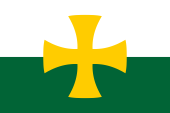
1918,
Flag of the Siberian Army,
ratio = 2:3,
Source, by: Wikipedia (RU)



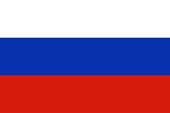
1918–1920,
Flag of the Kolchak Government,
ratio = 2:3,
Source, by: Wikipedia (RU)






1918–1920,
Coat of arms of the Kolchak Government,
Source, by: Wikipedia (DE)
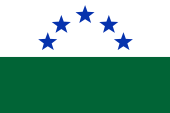
ca. 1995,
Flag of the United States of North Asia,
ratio = 2:3,
Source, by: Flags of the World,
Stateless Nations




today's unofficial flag of Siberia,
ratio = 2:3,
Source, by: Stateless Nations




The government of the Siberian Republic used a flag divided diagonally between green and white during its brief rule during the Russian Civil War. The colours officially represented the Taiga and the snow. The subsequent Provisional Government of the Autonomous Siberia retained the colours, but the flag showed two horizontal stripes of green and white (also reversed). The colours and white and green probably originated in the coat of arms of the Tomsk Voivodeship, which showed a white horse on a green background. Allegedly, the flag is used again today, representing fictitious regional interests. Likewise, the flag of the United States of North Asia, presumably an intended union of various Siberian nations and territories. The flag shows the usual two horizontal stripes in white and green, and five blue stars in the white field. The stars probably represent the Siberian, Tatar nations, because blue is the colour of the Tatar-Mongol race.
Admiral Alexander Wassilievich Kolchak was the war-minister of the Siberian government, but he seized the power on 18th of November in 1918. The anti-bolchevist alliance consisting of troops of Great Britain, of the USA, of Japan, of a Czechoslovak corps, of the troops of General Skoropadski and of the troops of the Ataman Krassnov recognized the new chief of government in Siberia. He nominated itself to the Supreme Regent of Russia, to the Reich Regent of the Russian Monarchy and to the Supreme Commander of all anti-bolchevist troops in Russia. Kolchak's troops used from now on Russian symbolism: The Russian tricolor in the colours white, blue and red, as well as coat of arms the Russian double eagle but coloured in ecru and without crowns, added by a big silvery cross and a blue banner with the Russian inscription "strength triumphs". In the claws the eagle held no scepter but a sword. Kolchak's army had initially big triumphs (Kolchak operated in April of 1919 near Kasan Town and even western of Volga River), but in June of the year 1919 he became defeated by the Red Army under the Commander Michail Wassilievich Frunse. To begin with he withdrawed to Omsk and fled in November 1919 of Irkutsk Town. Admiral Kolchak was betrayed by the Czechoslovak corps im January 1920, extradited to the Red Army and executed on 7th of February in 1920 in Irkutsk Town. He himself gave the fire order to the execution command.
Source: Wikipedia (RU),
Flags of the World,
Volker Preuß,
Jürgen Kaltschmitt

Area: 5.058.000 square miles
Inhabitants: 38.000.000 inh., mostly Russians, furthermore 460.000 Burjats, 440.000 Jakuts, 50.000 Samojeds, 36.000 Ewenks, 29.000 Ostjaks and ca. 100.000 illegal Chinese
Density of Population: 8 inh./sq.mi.
Capital: none
Languages: Russian, Jakutian, Burjatian ...
Currency: Russian currency
Time Zone: GMT + 6 h to +13 h
Source:
Wikipedia (D)

14th century · the Empire of the Golden Horde disintegrates, the Khanate Tyumen with its capital Chingi-Tura (Tümen) is formed from the remnants at the lower reaches of the rivers Ob, Irtysh and Tobol
ca. 1480 · the capital is moved to Isker (Sibir), hence Khanate Sibir
1582 · Battle of Chuvash Cape, conquest of the capital Isker by the Cossack leader Jermak
1587 · foundation of Tobolsk Town
1598 · final defeat against troops of the Russian voivode Andrei Wojeikow near today's town of Ordynskoye, end of the Khanate Sibir
1604 · foundation of Tomsk Town
ca. 1610 · the cossacks reach the Yennisey River, affiliation of the conquered territories to Russia
ca. 1632 · the cossacks reach the Lena River, affiliation of the conquered territories to Russia
ca. 1640 · the cossacks reach the Indigirka River, affiliation of the conquered territories to Russia
ca. 1649 · the cossacks reach the Anadyr River, affiliation of the conquered territories to Russia
1680 · Russian Cossacks reach the Pacific Ocean
1697 · the cossacks reach the Kamtchatka Peninsula, affiliation to Russia
17th–18th century · settlement of Siberia, especially along the rivers by cossacks, farmers and religious prosecuted believers
1711 · annexation of the Kuril Islands to Russia
1715–1763 · conquest of territories to the headwaters of Irtysh River
1784–1790 · conquest of Alaska
1858–1860 · conquest of territories to the rivers Amur and Ussuri
1867 · sell of Alaska to the USA
1875 · annexion of Sakhalin Island by Russia, ceding of the Kuril Islands to Japan
1891–1904 · construction of the trans-siberian railroad
1905 · ceding of South Sakhalin to Japan
November 1917 · bolchevist revolution in St. Petersburg and especially in the european part of Russia, in diverse regions of Russia arise resistance groups and counter-governments, in western Siberia establishes the Siberian Government (Duma) in the spring of the year 1918
16th of July 1918 · Tsar Nikolaus II. and his whole family get murderd by Bolshevists in Yekaterinburg
18th of November 1918 · coup d’état of Admiral Alexander Wassilievich Kolchak, he sets itself in Omsk Town on the top of the Siberian Government and nominates itself to the Supreme Regent of Russia, to the Reich Regent of the Russian Monarchy and to the Supreme Commander of all anti-bolchevist troops in Russia
June 1919 · defeat of Kolchak's troops against the Red Army, retreat ot Omsk Town
November 1919 · escape of Kolchak's government from Omsk to Irkutsk Town, conquest of Omsk by the Red Army
January 1920 · Admiral Kolchak is betrayed by the Czechoslovak corps and becomes extradited to the bolchevists
7th of February 1920 · assassination of Admiral Kolchak by a bolchevist court martial in Irkutsk
1920–1925 · establishment of the bolchevist Soviet system in Siberia
1925–1990 · Siberia becomes the favourite place of banishment of the communist system and room for scores of prison camps (Gulag), the communist tyranny costs solely under Stalin several millions lives of Russians
21st of December 1991 · end of the Soviet Union
Source: 1) Wikipedia (D), 2) Wikipedia (D), Volker Preuß

The name "Siberia" has its roots in the in the middle ages existing Tatar's Chanate of Sibir. It was situaded in the region around the today’s Tobolsk Town. The word "Siberia" is assembled by the Tatar words "sib" (sleep) and "ir" (ground). Siberia is the "Sleeping Land".
Source: Handbuch der geographischen Namen

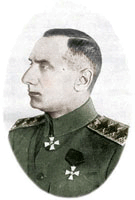
* 16th of November 1873 † 7th of February 1920
• Last Commander of the Russian Black Sea Fleet
• Chief of the Siberian Regional Duma
• Supreme Ruler of Russia
• Imperial Administrator of the Russian Monarchy
• Supreme Commander of the Anti-Bolshevik Forces in Russia
Admiral Alexander Vasilyevich Kolchak was one of the most tragic figures in world history. If he had prevailed with his troops in the Russian Civil War, history would have been completely different: A large part of the world would have been spared communism, the 60 million deaths for which the communist system alone is responsible in Russia would never have occurred, an Adolf Hitler and his National Socialists would never have been able to pose in Germany as opponents to the communist danger, and a Second World War would have been much less likely.
Source: 1) Wikipedia (D), 2) Wikipedia (D), Volker Preuß


![]()


























